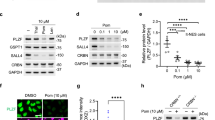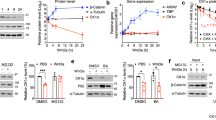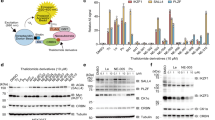Abstract
Thalidomide and its derivatives, lenalidomide and pomalidomide, are immune modulatory drugs (IMiDs) used in the treatment of haematologic malignancies1,2. IMiDs bind CRBN, the substrate receptor of the CUL4–RBX1–DDB1–CRBN (also known as CRL4CRBN) E3 ubiquitin ligase3, and inhibit ubiquitination of endogenous CRL4CRBN substrates4. Unexpectedly, IMiDs also repurpose the ligase to target new proteins for degradation. Lenalidomide induces degradation of the lymphoid transcription factors Ikaros and Aiolos (also known as IKZF1 and IKZF3)5,6,7, and casein kinase 1α (CK1α)8, which contributes to its clinical efficacy in the treatment of multiple myeloma5 and 5q-deletion associated myelodysplastic syndrome (del(5q) MDS)8, respectively. How lenalidomide alters the specificity of the ligase to degrade these proteins remains elusive. Here we present the 2.45 Å crystal structure of DDB1–CRBN bound to lenalidomide and CK1α. CRBN and lenalidomide jointly provide the binding interface for a CK1α β-hairpin-loop located in the kinase N-lobe. We show that CK1α binding to CRL4CRBN is strictly dependent on the presence of an IMiD. Binding of IKZF1 to CRBN similarly requires the compound and both, IKZF1 and CK1α, use a related binding mode. Our study provides a mechanistic explanation for the selective efficacy of lenalidomide in del(5q) MDS therapy8,9. We anticipate that high-affinity protein–protein interactions induced by small molecules will provide opportunities for drug development, particularly for targeted protein degradation.
This is a preview of subscription content, access via your institution
Access options
Subscribe to this journal
Receive 51 print issues and online access
$199.00 per year
only $3.90 per issue
Buy this article
- Purchase on SpringerLink
- Instant access to full article PDF
Prices may be subject to local taxes which are calculated during checkout




Similar content being viewed by others
References
Singhal, S. et al. Antitumor activity of thalidomide in refractory multiple myeloma. N. Engl. J. Med. 341, 1565–1571 (1999)
Bartlett, J. B., Dredge, K. & Dalgleish, A. G. The evolution of thalidomide and its IMiD derivatives as anticancer agents. Nature Rev. Cancer 4, 314–322 (2004)
Ito, T. et al. Identification of a primary target of thalidomide teratogenicity. Science 327, 1345–1350 (2010)
Fischer, E. S. et al. Structure of the DDB1–CRBN E3 ubiquitin ligase in complex with thalidomide. Nature 512, 49–53 (2014)
Krönke, J. et al. Lenalidomide causes selective degradation of IKZF1 and IKZF3 in multiple myeloma cells. Science 343, 301–305 (2014)
Lu, G. et al. The myeloma drug lenalidomide promotes the cereblon-dependent destruction of Ikaros proteins. Science 343, 305–309 (2014)
Gandhi, A. K. et al. Immunomodulatory agents lenalidomide and pomalidomide co-stimulate T cells by inducing degradation of T cell repressors Ikaros and Aiolos via modulation of the E3 ubiquitin ligase complex CRL4CRBN. Br. J. Haematol. 164, 811–821 (2014)
Krönke, J. et al. Lenalidomide induces ubiquitination and degradation of CK1α in del(5q) MDS. Nature 523, 183–188 (2015)
List, A. et al. Efficacy of lenalidomide in myelodysplastic syndromes. N. Engl. J. Med. 352, 549–557 (2005)
Sekeres, M. A. & List, A. Lenalidomide (Revlimid, CC-5013) in myelodysplastic syndromes: is it any good? Curr. Hematol. Rep. 4, 182–185 (2005)
Schneider, R. K. et al. Role of casein kinase 1A1 in the biology and targeted therapy of del(5q) MDS. Cancer Cell 26, 509–520 (2014)
Chamberlain, P. P. et al. Structure of the human Cereblon–DDB1–lenalidomide complex reveals basis for responsiveness to thalidomide analogs. Nature Struct. Mol. Biol. 21, 803–809 (2014)
Kornev, A. P., Haste, N. M., Taylor, S. S. & Eyck, L. F. Surface comparison of active and inactive protein kinases identifies a conserved activation mechanism. Proc. Natl Acad. Sci. USA 103, 17783–17788 (2006)
Schjerven, H. et al. Selective regulation of lymphopoiesis and leukemogenesis by individual zinc fingers of Ikaros. Nature Immunol. 14, 1073–1083 (2013)
Zhou, S. et al. Transport of thalidomide by the human intestinal caco-2 monolayers. Eur. J. Drug Metab. Pharmacokinet. 30, 49–61 (2005)
Hofmeister, C. C. et al. Phase I trial of lenalidomide and CCI-779 in patients with relapsed multiple myeloma: evidence for lenalidomide-CCI-779 interaction via P-glycoprotein. J. Clin. Oncol. 29, 3427–3434 (2011)
Krenn, M., Gamcsik, M. P., Vogelsang, G. B., Colvin, O. M. & Leong, K. W. Improvements in solubility and stability of thalidomide upon complexation with hydroxypropyl-beta-cyclodextrin. J. Pharm. Sci. 81, 685–689 (1992)
Roche, S. et al. Development, validation and application of a sensitive LC-MS/MS method for the quantification of thalidomide in human serum, cells and cell culture medium. J. Chromatogr. B 902, 16–26 (2012)
Fischer, E. S. et al. The molecular basis of CRL4DDB2/CSA ubiquitin ligase architecture, targeting, and activation. Cell 147, 1024–1039 (2011)
Angers, S. et al. Molecular architecture and assembly of the DDB1–CUL4A ubiquitin ligase machinery. Nature 443, 590–593 (2006)
Duda, D. M. et al. Structural insights into NEDD8 activation of cullin-RING ligases: conformational control of conjugation. Cell 134, 995–1006 (2008)
Mahon, C., Krogan, N. J., Craik, C. S. & Pick, E. Cullin E3 ligases and their rewiring by viral factors. Biomolecules 4, 897–930 (2014)
Winter, G. E. et al. Phthalimide conjugation as a strategy for in vivo target protein degradation. Science 348, 1376–1381 (2015)
Lu, J. et al. Hijacking the E3 ubiquitin ligase cereblon to efficiently target BRD4. Chem. Biol. 22, 755–763 (2015)
Milroy, L. G., Grossmann, T. N., Hennig, S., Brunsveld, L. & Ottmann, C. Modulators of protein-protein interactions. Chem. Rev. 114, 4695–4748 (2014)
Tan, X. et al. Mechanism of auxin perception by the TIR1 ubiquitin ligase. Nature 446, 640–645 (2007)
Griffith, J. P. et al. X-ray structure of calcineurin inhibited by the immunophilin-immunosuppressant FKBP12-FK506 complex. Cell 82, 507–522 (1995)
Hartmann, M. D. et al. Thalidomide mimics uridine binding to an aromatic cage in cereblon. J. Struct. Biol. 188, 225–232 (2014)
Abdulrahman, W. et al. A set of baculovirus transfer vectors for screening of affinity tags and parallel expression strategies. Anal. Biochem. 385, 383–385 (2009)
Kabsch, W. Xds. Acta Crystallogr. D 66, 125–132 (2010)
Winn, M. D. et al. Overview of the CCP4 suite and current developments. Acta Crystallogr. D 67, 235–242 (2011)
Karplus, P. A. & Diederichs, K. Linking crystallographic model and data quality. Science 336, 1030–1033 (2012)
McCoy, A. J. et al. Phaser crystallographic software. J. Appl. Crystallogr. 40, 658–674 (2007)
Šali, A., Potterton, L., Yuan, F., van Vlijmen, H. & Karplus, M. Evaluation of comparative protein modeling by MODELLER. Proteins 23, 318–326 (1995)
Afonine, P. V. et al. Towards automated crystallographic structure refinement with phenix.refine. Acta Crystallogr. D 68, 352–367 (2012)
Bricogne, G. B. E. et al. BUSTER version 2.11.5. (Global Phasing Ltd., 2011)
Chen, V. B. et al. MolProbity: all-atom structure validation for macromolecular crystallography. Acta Crystallogr. D 66, 12–21 (2010)
Krissinel, E. & Henrick, K. Inference of macromolecular assemblies from crystalline state. J. Mol. Biol. 372, 774–797 (2007)
Cer, R. Z., Mudunuri, U., Stephens, R. & Lebeda, F. J. IC50-to-Ki: a web-based tool for converting IC50 to Ki values for inhibitors of enzyme activity and ligand binding. Nucleic Acids Res. 37, W441–W445 (2009)
Marks, B. D. et al. Multiparameter analysis of a screen for progesterone receptor ligands: comparing fluorescence lifetime and fluorescence polarization measurements. Assay Drug Dev. Technol. 3, 613–622 (2005)
Cox, J. & Mann, M. MaxQuant enables high peptide identification rates, individualized p.p.b.-range mass accuracies and proteome-wide protein quantification. Nature Biotechnol. 26, 1367–1372 (2008)
Acknowledgements
This work was supported by the Novartis Research Foundation, the Swiss National Science Foundation (31003A_144020) and the European Research Council (ERC-2014-ADG 666068 CsnCRL). G.P. was supported by Long-Term Fellowships of the European Molecular Biology Organization (EMBO; ALTF-1350-2013) and the Human Frontier Science Program (HFSP; LT000210/2014). We thank G. M. Lingaraju for the DDB1∆BPB construct, M. Faty for assistance with protein purifications, J. Rabl and S. Kassube for help during diffraction data collection, R. Bunker for support with data processing and model building, W. A. Rahman and A. Potenza for assistance with fluorescence polarization, W. C. Forrester for help and comments, and J. Seebacher, R. Sack, D. Hess and M. Stadler for help with mass spectrometry experiments. We acknowledge the Paul Scherrer Institute for provision of synchrotron radiation beam time at beamline PXII and PXIII of the SLS and would like to thank M. Wang for assistance.
Author information
Authors and Affiliations
Contributions
G.P., E.S.F. and N.H.T. designed the experiments and interpreted the results. G.P. and E.S.F. carried out the experiments. G.P., E.S.F. and N.H.T. wrote the manuscript.
Corresponding author
Ethics declarations
Competing interests
The authors declare no competing financial interests.
Extended data figures and tables
Extended Data Figure 1 Characterization of the CRL4CRBN–CK1α interaction.
a, TR-FRET setup. b, Neddylation of CRL4CRBN with Alexa 488-labelled NEDD8. c, Titration of lenalidomide, pomalidomide and thalidomide (0.0025–2.5 μM) to N8CRL4CRBN at 300 nM and CK1α at 100 nM. EC50 values show that similar compound concentrations are required to bind CK1α to N8CRL4CRBN. d, Unlabelled DDB1∆BPB–CRBN competes with N8CRL4CRBN for CK1α binding. Titration of unlabelled wild-type DDB1∆BPB–CRBN (0.02–20 μM) to N8CRL4CRBN–lenalidomide–CK1α complexes pre-assembled by mixing N8CRL4CRBN at 450 nM, CK1α at 100 nM and lenalidomide at 10 μM (blue curve). Addition of buffer to N8CRL4CRBN–lenalidomide–CK1α (green curve; maximum signal) and N8CRL4CRBN, CK1α without lenalidomide (red curve; minimum signal). IC50 was converted to the respective Ki as described in methods. The resulting Ki is similar to the KD as determined by non-competitive TR-FRET (Fig. 1a). e, Binding of Cy5-labelled thalidomide to CRBN mutants (DDB1–CRBN) determined by fluorescence polarization. Data in this figure are biological replicates presented as means ± s.d. (n = 3).
Extended Data Figure 2 The asymmetric unit contains two quaternary complexes.
a, DDB1∆BPB–CRBN superimposes on DDB1–CRBN (PDB entry 4TZ4; grey) with an overall r.m.s.d. of 0.96 Å. b, CRBN helical bundle domains (HBD) extracted from a. The CRBN–HBDs superimpose with an overall r.m.s.d. of 0.44 Å. c, The DDB1∆BPB–CRBN–lenalidomide–CK1α crystal contained two quaternary complexes in the unit cell. The two complexes are shown as cartoon representation coloured according to B factor. Lenalidomide is shown as spheres. Average B-factors for different parts of the molecule are provided.
Extended Data Figure 3 CK1α adopts an active kinase conformation.
a, C-terminal domain of CRBN, lenalidomide and CK1α. Elements required for kinase activation are indicated. b, Superposition of CK1α with inactive c-Src kinase (PDB entry 2SRC; orange) and an active conformation of human lymphocyte kinase Lck (PDB entry 3LCK; grey) shown in two different orientations. Conformational differences in the activation segment and the αC-helix are indicated. c, Close-up of the αC-helix of CK1α. The DFG motif makes hydrophobic contacts with the αC-helix. The Lys–Glu hydrogen bond (dashed line) is characteristic of an active kinase conformation. d, Superposition of the DFG motifs of CK1α, c-Src and Lck. The CK1α DFG motif adopts an active conformation. e, Superposition of the HRD motifs of CK1α, c-Src and Lck. The CK1α HRD motif adopts an active conformation.
Extended Data Figure 4 CK1α binding induces minor changes in CRBN.
a, Superposition of DDB1∆BPB–CRBN–lenalidomide–CK1α (coloured as in Fig. 1c) with human DDB1–CRBN (PDB 4TZ4) in grey. Only the CRBN residues His353 and Tyr355 undergo minor rearrangements upon CK1α binding. b, Lenalidomide orientation (shown as spheres) in the DDB1∆BPB–CRBN–lenalidomide–CK1α complex. C3 of the phthalimide group is close to the main chain carbonyl group of Glu377 (shown as spheres). c, Orientation of lenalidomide in the structure of human DDB1–CRBN (PDB entry 4TZ4; grey) superimposed with DDB1∆BPB–CRBN–lenalidomide–CK1α. Clashes of phthalimide C6 and C7 with CK1α are indicated by an arrow. d, e, Thalidomide (d) and pomalidomide (e) in the structure of Homo sapiens DDB1 and Gallus gallus CRBN (PDB entry 4CI1 and 4CI3) in grey. The β-strands 10 and 11 are in an identical conformation as compared to lenalidomide-bound human DDB1–CRBN (PDB entry 4TZ4) and are not differentially regulated by binding to different IMiDs8. f, Total intensity measurements of different Alexa-488-labelled N8CRL4CRBN mutant complexes confirms comparable labelling efficiency (AU, arbitrary units). Data are biological replicates presented as means ± s.d. (n = 3).
Extended Data Figure 5 Conservation of the CRBN–CK1α interface.
a, Sequence of the interacting CK1α β-hairpin loop aligned to different CK1 and CK2 isoforms. b, Superposition of the CK1α and CK2α (PDB entry 3U87) β-hairpin loops. CK2α residue Asn62 aligns with CK1α residue Gly40 and clashes with lenalidomide. c, Quantification of CK1α and CK2α cellular abundance using label-free quantification mass spectrometry. Two-tailed paired t-test analysis revealed significant differences between CK2β, CK2α1/3, CK2α2 and CK1α with P < 0.05. Data are biological replicates presented as means ± s.d. (n = 3). d, Sequence alignment of human and mouse CRBN C-terminal domains. Asterisks indicate residues that contact CK1α. Orange dots mark residues required for IMiD binding. Arrows highlight the four diverging residues. Human CRBN residues C366 and D428 are not part of the CRBN–CK1α interface. e, Superposition of CRBN–lenalidomide–CK1α (coloured as in Fig. 1c) with chicken CRBN (PDB entry 4CI2) in grey. CRBN Pro352 and CK1α Gly40 make close contacts with the phthalimide ring of lenalidomide. CRBN Val388 is close to CK1α Gly40 (arrow; middle panel). Substitution of Val388 for isoleucine leads to clashes with CK1α, as illustrated by chicken CRBN Ile390 (arrow; right panel).
Extended Data Figure 6 Characterization of the CRL4CRBN–IKZF1 interaction.
a, N8CRL4CRBN–IKZF1 complex formation measured by TR-FRET in the absence (DMSO) or presence of lenalidomide, pomalidomide or thalidomide at saturating concentrations (5 μM). b, Titration of lenalidomide, pomalidomide and thalidomide (0.0025–2.5 μM) to N8CRL4CRBN at 200 nM and IKZF1 at 80 nM. EC50 values show that equal compound concentrations are required to bind IKZF1 to N8CRL4CRBN. c, Titration of unlabelled wild-type DDB1∆BPB–CRBN (0.02–20 μM) to N8CRL4CRBN–lenalidomide–IKZF1 complexes pre-assembled by mixing N8CRL4CRBN at 250 nM, IKZF1 at 70 nM and pomalidomide at 10 μM. Addition of buffer to N8CRL4CRBN–pomalidomide–IKZF1 (green curve; maximum TR-FRET signal) and N8CRL4CRBN, IKZF1 without pomalidomide (red curve; minimum TR-FRET signal). IC50 values were converted to the respective Ki as described in methods. Data in this figure are biological replicates presented as means ± s.d. (n = 3).
Extended Data Figure 7 IKZF1 utilizes a β-hairpin loop to bind CRBN.
a, Overview of IKZF1 constructs. ZF, zinc finger; Q, Gln146. Hatched lines indicate omitted sequences. b, Sequence alignment between human IKZF1–ZF2, the β-hairpin loop of human CK1α and Aart (PDB 2I13; residues 133–158). PDB entries 2I13, 2LT7 and 1UBD were used for IKZF1 modelling. c, Superposition of modelled IKZF1–ZF2 with the CK1α β-hairpin loop. d, Unlabelled wild-type or mutant IKZF183–196/239–255 (0.02–10 μM) added to N8CRL4CRBN–pomalidomide–IKZF11–196/239–255 complexes pre-assembled by mixing N8CRL4CRBN at 250 nM, IKZF11–196/239–255 at 80 nM and pomalidomide at 5 μM. N8CRL4CRBN–pomalidomide–IKZF1 complex (red curve; maximum TR-FRET signal). N8CRL4CRBN, IKZF1 without pomalidomide (blue curve; minimum TR-FRET signal). e, CBRN–CK1α interface. f, Model of the CRBN–IKZF1 interface. CRBN Gln390 is proximal to IKZF1 His163 in the α-helix of ZF2. g, Mutation of CK1α Glu41 to alanine, the corresponding residue in IKZF1, strengthens binding (KD = 109 ± 30 nM). h, Mutation of CRBN Gln390 to arginine has no substantial influence on CK1α binding, but interferes with IKZF1 recruitment (i) as predicted by the model. TR-FRET data in this figure are biological replicates presented as means ± s.d. (n = 3).
Extended Data Figure 8 Presence of IKZF1 consensus DNA interferes with binding to CRBN.
a, Model of IKZF1 bound to DNA and CRBN. DNA clashes with the zinc-binding region of CRBN. b, Electrophoretic mobility shift assay. IKZF183–196/239–255 specifically binds its consensus DNA (cons. DNA). c, Electrophoretic mobility shift assay. Presence of DNA affects the interaction between DDB1–CRBN, pomalidomide and IKZF1. DNA does not comigrate with the DDB1–CRBN–IKZF1 complex. DDB1–CRBN and IKZF1 do not interact in the absence of pomalidomide. d, IKZF1 pre-incubated with equimolar concentrations of DNA shows reduced binding to N8CRL4CRBN in TR-FRET. Titration of unlabelled IKZF183–196/239–255 (0.02–10 μM) pre-incubated with control, consensus or no DNA. Unlabelled IKZF1 was added to N8CRL4CRBN–pomalidomide–IKZF1 complexes pre-assembled by mixing N8CRL4CRBN at 250 nM, IKZF11–196/239–255 at 80 nM and pomalidomide at 5 μM. Addition of buffer to N8CRL4CRBN–pomalidomide–IKZF1 (red curve; maximum TR-FRET signal) and N8CRL4CRBN, IKZF1 without pomalidomide (blue curve; minimum TR-FRET signal). Data are biological replicates presented as means ± s.d. (n = 3).
Extended Data Figure 9 In vitro ubiquitination of CK1α and identification of target lysines.
a, In vitro ubiquitination of CK1α by N8CRL4CRBN in the presence different IMiDs at 10 μM ([IMiD] >> KD). b, Model of CRL4CRBN bound to CK1α. Ubiquitin target lysines of CK1α are shown as spheres and represent sites identified by mass spectrometry following in vitro (yellow) or in vivo8 (blue) ubiquitination. Lys62, 65 and 179 are close to the CUL4 orientation, whereas Lys8 and 225 can be reached in CUL4′ orientation. c, TR-FRET of N8CRL4CRBN–CK1α complex formation in the presence of lenalidomide or 2′-deoxyuridine at 5 μM. 2′-deoxyuridine does not mediate interaction between N8CRL4CRBN and CK1α. Data are biological replicates presented as means ± s.d. (n = 3).
Supplementary information
Supplementary Figure
This file contains uncropped scans with size marker indications. (PDF 376 kb)
Rights and permissions
About this article
Cite this article
Petzold, G., Fischer, E. & Thomä, N. Structural basis of lenalidomide-induced CK1α degradation by the CRL4CRBN ubiquitin ligase. Nature 532, 127–130 (2016). https://doi.org/10.1038/nature16979
Received:
Accepted:
Published:
Issue Date:
DOI: https://doi.org/10.1038/nature16979



